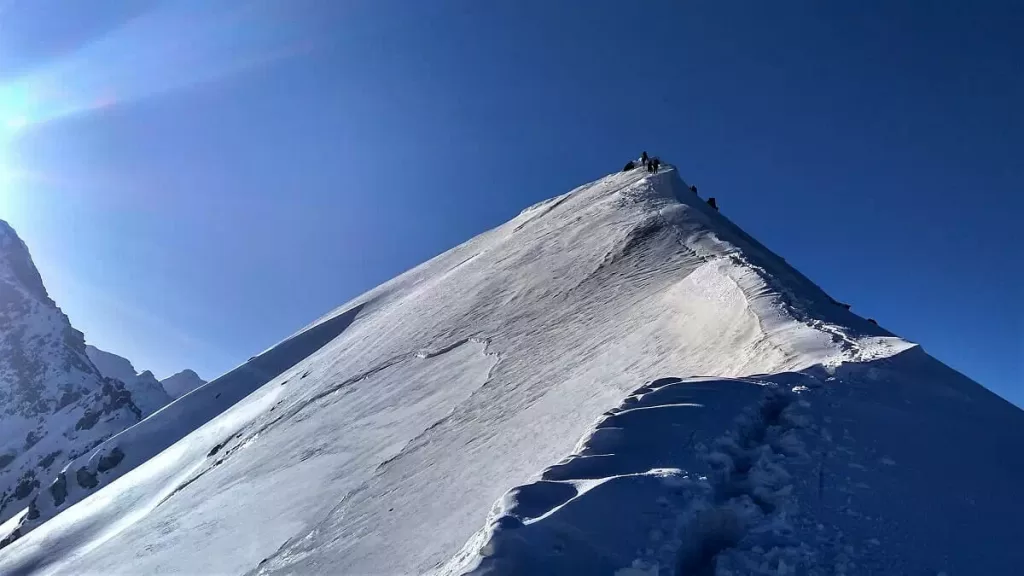Bali Pass trek
Duration : 8 Days 7 Nights
The Price : ₹16,950.00
Max People : 20
Age Range : 18 - 63
Bali Pass is a mountain pass that peaks slightly short of 5000 meters mark, and connects the Har Ki Dun – Ruinsara Valley to Yamunotri and vice-versa. The trek runs through numerous heritage Villages of Har Ki Dun valley such as Osla, Gangaad, Taluka and ascends deep into the Govind National Park. On the route we come across the beautiful Ruinsara Lake. Multiple Waterfalls lie on the way to the pass.
Bali Pass trek distance is 66 KM from Taluka to Janki Chatti. The trek is on the difficult end as Bali Pass trek altitude is more than 16000 feet and has long walking days, with steeps ascents and descents. If one plans to attempt Bali Pass trek solo, it is highly advised to trek along a route guide as it is easy to misjudge the trail while descending or ascending the pass, with steep sections which can cause mishaps.
How to plan Bali Pass trek?
The pass is more approachable from the Har Ki Dun valley as the gradient is less steep and gives good time for the trekkers to acclimatize to the altitude. Although a few trekkers start the trek from Yamunotri too, which is not generally recommended. It is because the altitude gain from Yamunotri is very quick and the steep trail cab quickly tire trekkers. It can even lead to acute mountain sickness as there is barely any acclimatization to the high altitude. The route from Sankri has multiple campsites on the route and the itinerary can be easily changed as per convenience of trekkers. Generally the pass is attempted from Thanga, situated at 4100 meters. However, we can push to camp further at the base camp at a whopping 4,600 meters of altitude. This reduces the strain for the pass crossing day and further gives a unique experience of camping at a very high altitude. The Swargarohini has astounding views from the Bali Pass basecamp.
What makes Bali Pass trek a great choice?
Bali Pass trek has a lot to offer apart from its virgin trails and a challenging pass climb. We are surrounded either by the mighty Swargarohini or Bandarpunch ranges at almost all times. We get to see Kalanag (Black Peak) & Swargarohini Peak up close. At 6,387 meters, the Kalanag peak is highest in this region. This peak was first summited by Jack Gibson in 1955 and the students of Doon school. We spend a day beside the Ruinsara Lake. The walk across the two meadows of Devsu Thatch and Thanga is breathtaking. One of our camps will be beside a waterfall and another one lies above 4,000 m. Wild animals such as Himalayan Ibex and Blue Sheep, Black Bears, Brown bears can be spotted occasionally on this trail! Our teams have sighted the Black bear on this trail ahead of Seema and near the waterfall camp, while the Brown bear was spotted near Thanga Campsite, and during an exploration towards Dhumdhar Kandi pass during the rest day at Ruinsara Lake. While the trail to Bali pass turns southward towards Yamunotri ahead of Ruinsara Lake, the eastward route continues to the challenging Dhumdhar Kandi. Its a daunting pass sharing its base camp with Black Peak and goes to Harsil. The Bali pass unlike a conventional pass, which means a saddle like opening between neighboring rising ridge, rises like a peak and gives a summit like adventure when you reach the top. The same can be visually seen in the summit stretch picture of Bali pass below. Towards the end of the Bali Pass trek, we see the Bandarpunch Glacier & Saptrishi Kund. They are the true source of river Yamuna. We also get an opportunity to visit the holy temple of Yamunotri. All in all, Bali Pass is a wholesome adventure that provides trekkers with every element of a Himalayan trek.

How difficult is Bali Pass trek?
Bali pass trek difficulty is based on the following factors – the pass has a maximum height (altitude) of 16,080 feet or 4,900 meters. The trek has a distance of 66 KM in total, starting from Taluka to the end point at Janki Chatti. It takes 6 to 7 days to complete the trek on foot. Thus we will walk around 10 KM on average everyday. The altitude of Taluka, where the trek starts from, is 6,825 feet (2080 meters). We thus have a net altitude gain of 9,250 feet (2,820 meters) over a duration of 5 days, thus climbing average of 550 meters a day or 1800 feet. That is a considerable altitude gain. The distance, altitude gain and finally the technical pass crossing make Bali Pass fall in the category of a Difficult trek. It requires physical preparation and regular exercises that must be started at least 1 month prior to trekking to the Bali Pass.
Check out Bali Pass Trek’s Images.

